
Chinese Journal of Applied Chemistry ›› 2022, Vol. 39 ›› Issue (8): 1262-1273.DOI: 10.19894/j.issn.1000-0518.210185
• Full Papers • Previous Articles Next Articles
Synergistic Effect of Ternary Compound System of Sodium N‑Lauroyl Methylalanine
Ying LI2, Yun ZHANG1, Liang-Liang LIN2, Hu-Jun XU2( )
)
- 1.Suzhou Greenleaf Daily Commodity Co. ,Ltd,Suzhou 215151,China
2.School of Chemistry and Materials Engineering,Jiangnan University,Wuxi 214122,China
-
Received:2021-04-13Accepted:2021-08-28Published:2022-08-01Online:2022-08-04 -
Contact:Hu-Jun XU -
About author:xu6209@163.com
-
Supported by:the National Natural Science Foundation of China(52004102);the Natural Science Foundation of Jiangsu Province(BK20190605)
CLC Number:
Cite this article
Ying LI, Yun ZHANG, Liang-Liang LIN, Hu-Jun XU. Synergistic Effect of Ternary Compound System of Sodium N‑Lauroyl Methylalanine[J]. Chinese Journal of Applied Chemistry, 2022, 39(8): 1262-1273.
share this article
Add to citation manager EndNote|Ris|BibTeX
URL: http://yyhx.ciac.jl.cn/EN/10.19894/j.issn.1000-0518.210185
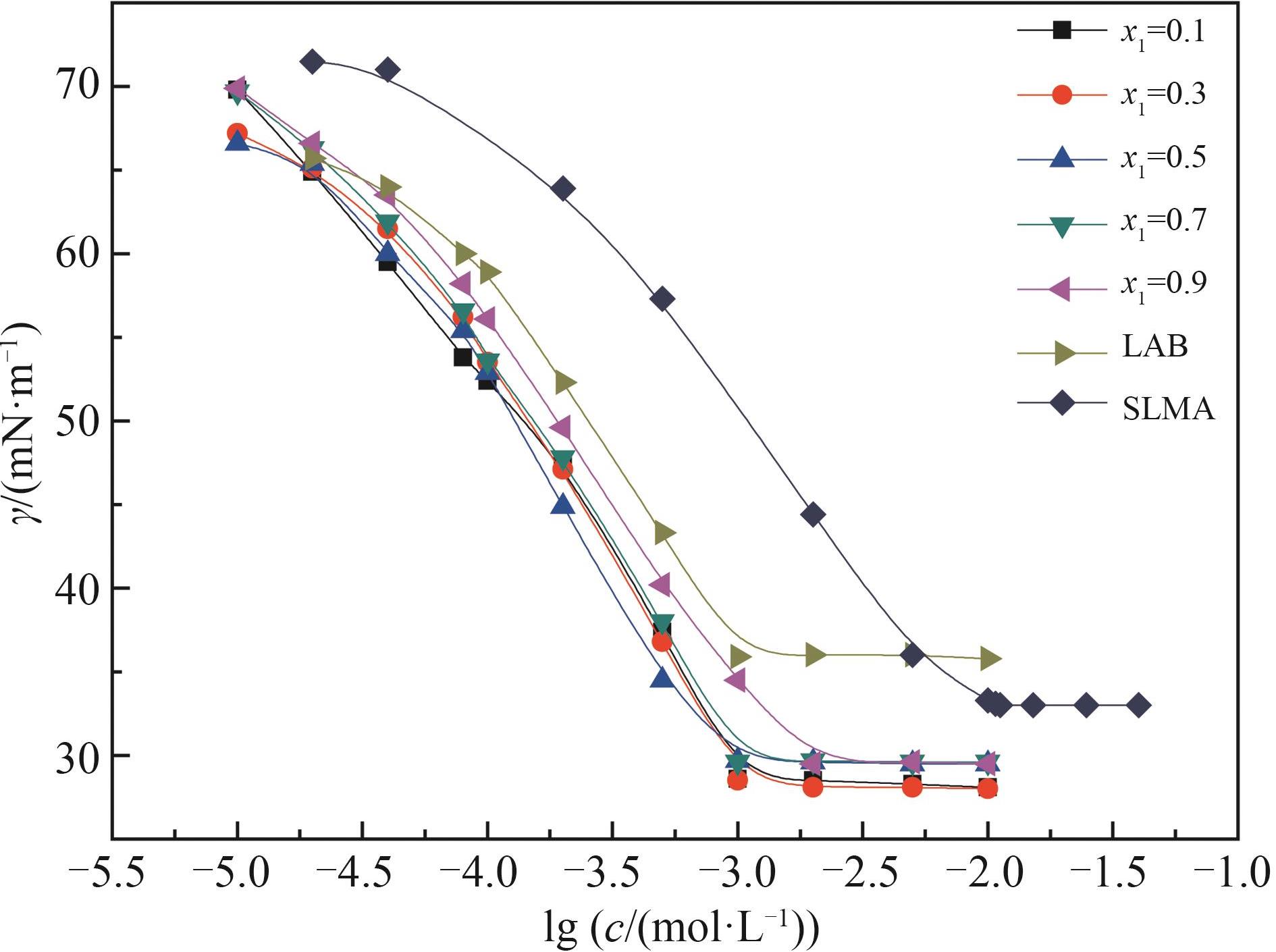
Fig.1 γ-lgc curves of SLMA/LAB binary compound system in different proportions at 25 ℃x1 is the molar fraction of SLMA in the solution phase; SLMA is N?lauroyl methylalanine sodium; LAB is lauramide propyl betaine
| x1 | CMC/(mol·L-1) | γCMC/(mN·m-1) | pc20 | CMC/c20 | Γmax/(μmol·m-2) | Amin/nm2 | Aideal,min/nm2 |
|---|---|---|---|---|---|---|---|
| 0 | 1.066×10-3 | 35.80 | 3.69 | 5.22 | 3.95 | 0.42 | 0.42 |
| 0.1 | 1.065×10-3 | 28.10 | 3.86 | 7.71 | 4.72 | 0.35 | 0.44 |
| 0.3 | 1.054×10-3 | 28.00 | 3.88 | 8.00 | 4.65 | 0.36 | 0.44 |
| 0.5 | 9.139×10-4 | 29.50 | 3.98 | 8.63 | 4.21 | 0.39 | 0.45 |
| 0.7 | 1.060×10-3 | 29.60 | 3.91 | 8.52 | 4.22 | 0.39 | 0.45 |
| 0.9 | 1.827×10-3 | 29.50 | 3.82 | 12.15 | 3.63 | 0.46 | 0.46 |
| 1 | 7.913×10-3 | 32.40 | 3.10 | 9.98 | 3.43 | 0.48 | 0.48 |
Table 1 Surface activity parameters of the SLMA/LAB binary compound system
| x1 | CMC/(mol·L-1) | γCMC/(mN·m-1) | pc20 | CMC/c20 | Γmax/(μmol·m-2) | Amin/nm2 | Aideal,min/nm2 |
|---|---|---|---|---|---|---|---|
| 0 | 1.066×10-3 | 35.80 | 3.69 | 5.22 | 3.95 | 0.42 | 0.42 |
| 0.1 | 1.065×10-3 | 28.10 | 3.86 | 7.71 | 4.72 | 0.35 | 0.44 |
| 0.3 | 1.054×10-3 | 28.00 | 3.88 | 8.00 | 4.65 | 0.36 | 0.44 |
| 0.5 | 9.139×10-4 | 29.50 | 3.98 | 8.63 | 4.21 | 0.39 | 0.45 |
| 0.7 | 1.060×10-3 | 29.60 | 3.91 | 8.52 | 4.22 | 0.39 | 0.45 |
| 0.9 | 1.827×10-3 | 29.50 | 3.82 | 12.15 | 3.63 | 0.46 | 0.46 |
| 1 | 7.913×10-3 | 32.40 | 3.10 | 9.98 | 3.43 | 0.48 | 0.48 |
| x1 | x1m | βm | x1σ | βσ | βσ-βm | |||
|---|---|---|---|---|---|---|---|---|
| 0.1 | 0.09 | -2.21 | 2.00 | 0.23 | -4.37 | 1.36 | -2.15 | 0.65 |
| 0.3 | 0.20 | -2.52 | 2.00 | 0.32 | -4.01 | 1.36 | -1.50 | 0.65 |
| 0.5 | 0.33 | -3.95 | 2.00 | 0.40 | -5.08 | 1.36 | -1.12 | 0.65 |
| 0.7 | 0.41 | -4.16 | 2.00 | 0.46 | -5.01 | 1.36 | -0.84 | 0.65 |
| 0.9 | 0.52 | -3.89 | 2.00 | 0.55 | -5.89 | 1.36 | -2.00 | 0.65 |
Table 2 Intermolecular interaction parameters of the SLMA/LAB binary compound system
| x1 | x1m | βm | x1σ | βσ | βσ-βm | |||
|---|---|---|---|---|---|---|---|---|
| 0.1 | 0.09 | -2.21 | 2.00 | 0.23 | -4.37 | 1.36 | -2.15 | 0.65 |
| 0.3 | 0.20 | -2.52 | 2.00 | 0.32 | -4.01 | 1.36 | -1.50 | 0.65 |
| 0.5 | 0.33 | -3.95 | 2.00 | 0.40 | -5.08 | 1.36 | -1.12 | 0.65 |
| 0.7 | 0.41 | -4.16 | 2.00 | 0.46 | -5.01 | 1.36 | -0.84 | 0.65 |
| 0.9 | 0.52 | -3.89 | 2.00 | 0.55 | -5.89 | 1.36 | -2.00 | 0.65 |
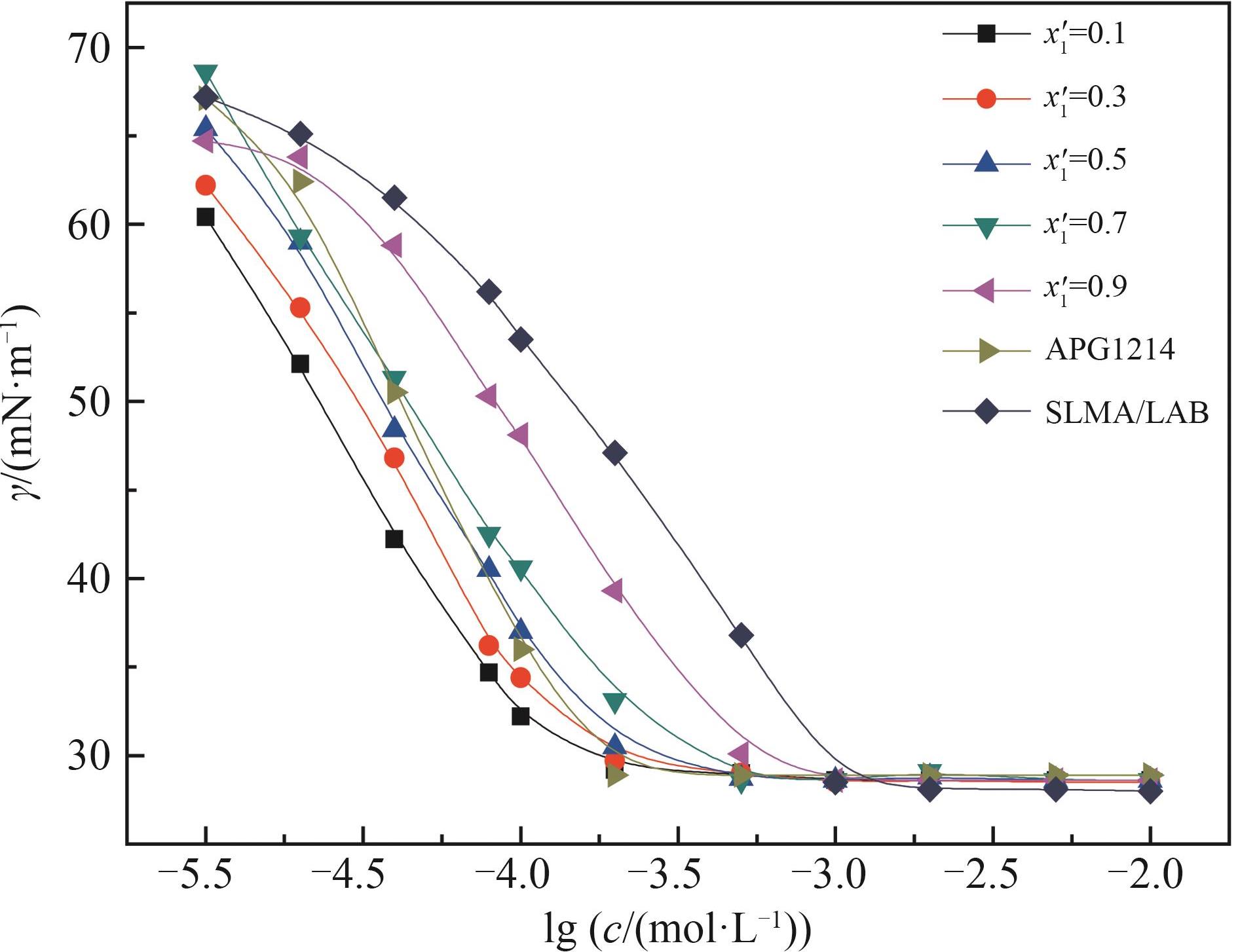
Fig.2 γ-lgc curves of SLMA/LAB/APG ternary compound system in different proportions at 25 ℃Note:x1' is the molar fraction of SLMA/LAB with molar ratio of 3∶7 in the solution phase; APG is alkyl glycoside
| CMC/(mol·L-1) | γCMC/(mN·m-1) | pc20 | CMC/c20 | Γmax/(μmol·m-2) | Amin/nm2 | Aideal,min/nm2 | |
|---|---|---|---|---|---|---|---|
| 0 | 1.812×10-4 | 28.90 | 4.42 | 4.81 | 5.93 | 0.28 | 0.28 |
| 0.1 | 1.293×10-4 | 28.60 | 4.71 | 6.63 | 4.99 | 0.33 | 0.30 |
| 0.3 | 1.595×10-4 | 28.50 | 4.61 | 6.57 | 5.04 | 0.33 | 0.31 |
| 0.5 | 2.166×10-4 | 28.60 | 4.50 | 6.90 | 4.89 | 0.34 | 0.31 |
| 0.7 | 2.740×10-4 | 28.60 | 4.42 | 7.17 | 4.79 | 0.35 | 0.32 |
| 0.9 | 5.793×10-4 | 28.60 | 4.18 | 8.73 | 4.36 | 0.38 | 0.33 |
| 1 | 1.040×10-3 | 28.00 | 3.93 | 8.79 | 4.65 | 0.36 | 0.36 |
Table 3 Surface activity parameters of the SLMA/LAB/APG ternary compound system
| CMC/(mol·L-1) | γCMC/(mN·m-1) | pc20 | CMC/c20 | Γmax/(μmol·m-2) | Amin/nm2 | Aideal,min/nm2 | |
|---|---|---|---|---|---|---|---|
| 0 | 1.812×10-4 | 28.90 | 4.42 | 4.81 | 5.93 | 0.28 | 0.28 |
| 0.1 | 1.293×10-4 | 28.60 | 4.71 | 6.63 | 4.99 | 0.33 | 0.30 |
| 0.3 | 1.595×10-4 | 28.50 | 4.61 | 6.57 | 5.04 | 0.33 | 0.31 |
| 0.5 | 2.166×10-4 | 28.60 | 4.50 | 6.90 | 4.89 | 0.34 | 0.31 |
| 0.7 | 2.740×10-4 | 28.60 | 4.42 | 7.17 | 4.79 | 0.35 | 0.32 |
| 0.9 | 5.793×10-4 | 28.60 | 4.18 | 8.73 | 4.36 | 0.38 | 0.33 |
| 1 | 1.040×10-3 | 28.00 | 3.93 | 8.79 | 4.65 | 0.36 | 0.36 |
| 0.1 | 0.21 | -4.56 | 1.75 | 0.28 | -5.49 | 1.14 | -0.93 | 0.60 |
| 0.3 | 0.25 | -3.04 | 1.75 | 0.33 | -3.65 | 1.14 | -0.61 | 0.60 |
| 0.5 | 0.29 | -2.04 | 1.75 | 0.38 | -2.71 | 1.14 | -0.68 | 0.60 |
| 0.7 | 0.39 | -1.99 | 1.75 | 0.47 | -2.58 | 1.14 | -0.59 | 0.60 |
| 0.9 | 0.58 | -0.82 | 1.75 | 0.64 | -1.79 | 1.14 | -0.98 | 0.60 |
Table 4 Intermolecular interaction parameters of the SLMA/LAB/APG ternary compound system
| 0.1 | 0.21 | -4.56 | 1.75 | 0.28 | -5.49 | 1.14 | -0.93 | 0.60 |
| 0.3 | 0.25 | -3.04 | 1.75 | 0.33 | -3.65 | 1.14 | -0.61 | 0.60 |
| 0.5 | 0.29 | -2.04 | 1.75 | 0.38 | -2.71 | 1.14 | -0.68 | 0.60 |
| 0.7 | 0.39 | -1.99 | 1.75 | 0.47 | -2.58 | 1.14 | -0.59 | 0.60 |
| 0.9 | 0.58 | -0.82 | 1.75 | 0.64 | -1.79 | 1.14 | -0.98 | 0.60 |
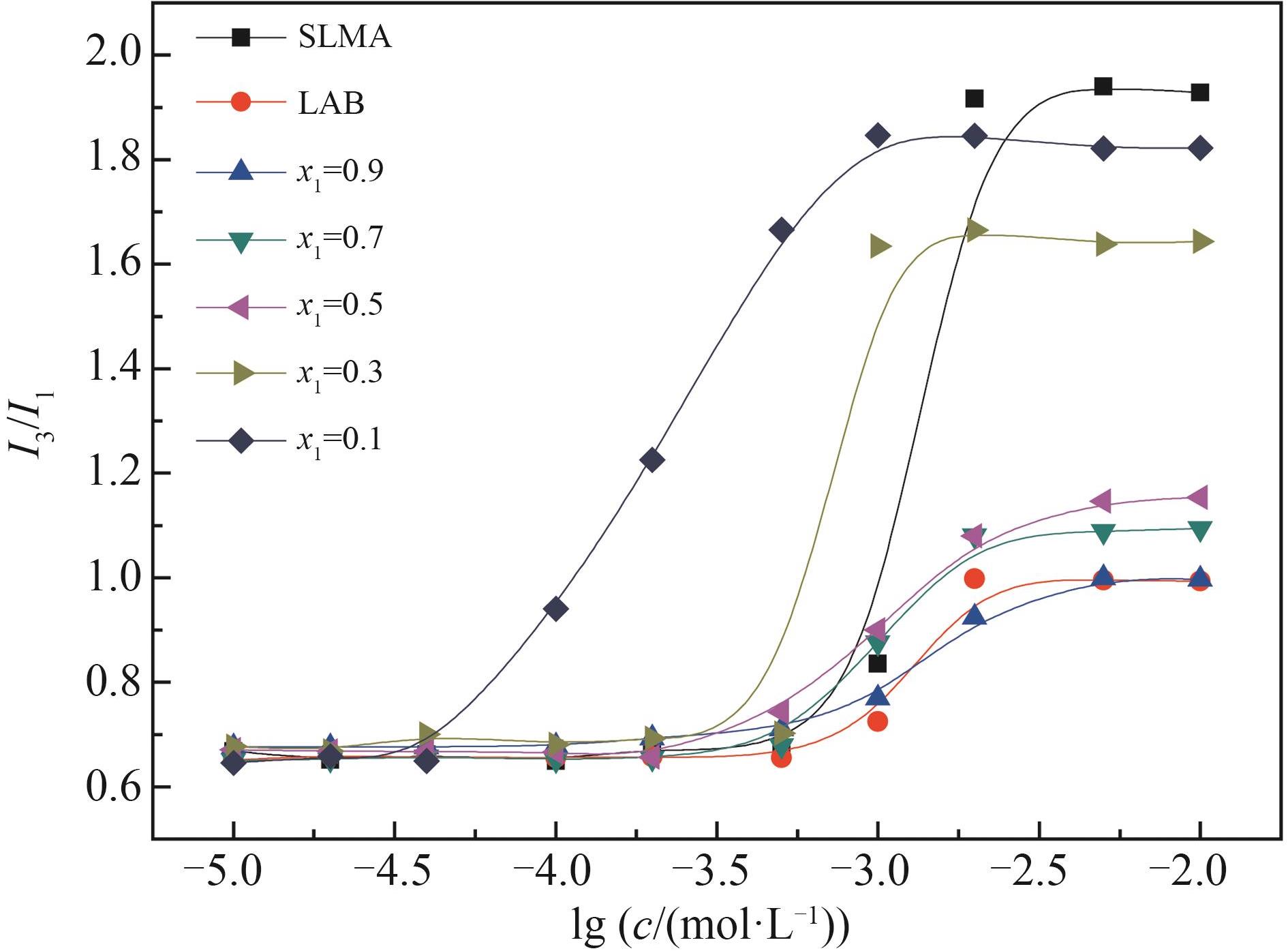
Fig.3 Micro-polarity curves of the SLMA/LAB binary compound system in different proportions at 25 ℃Note:x1 is the molar fraction of SLMA in the solution phase
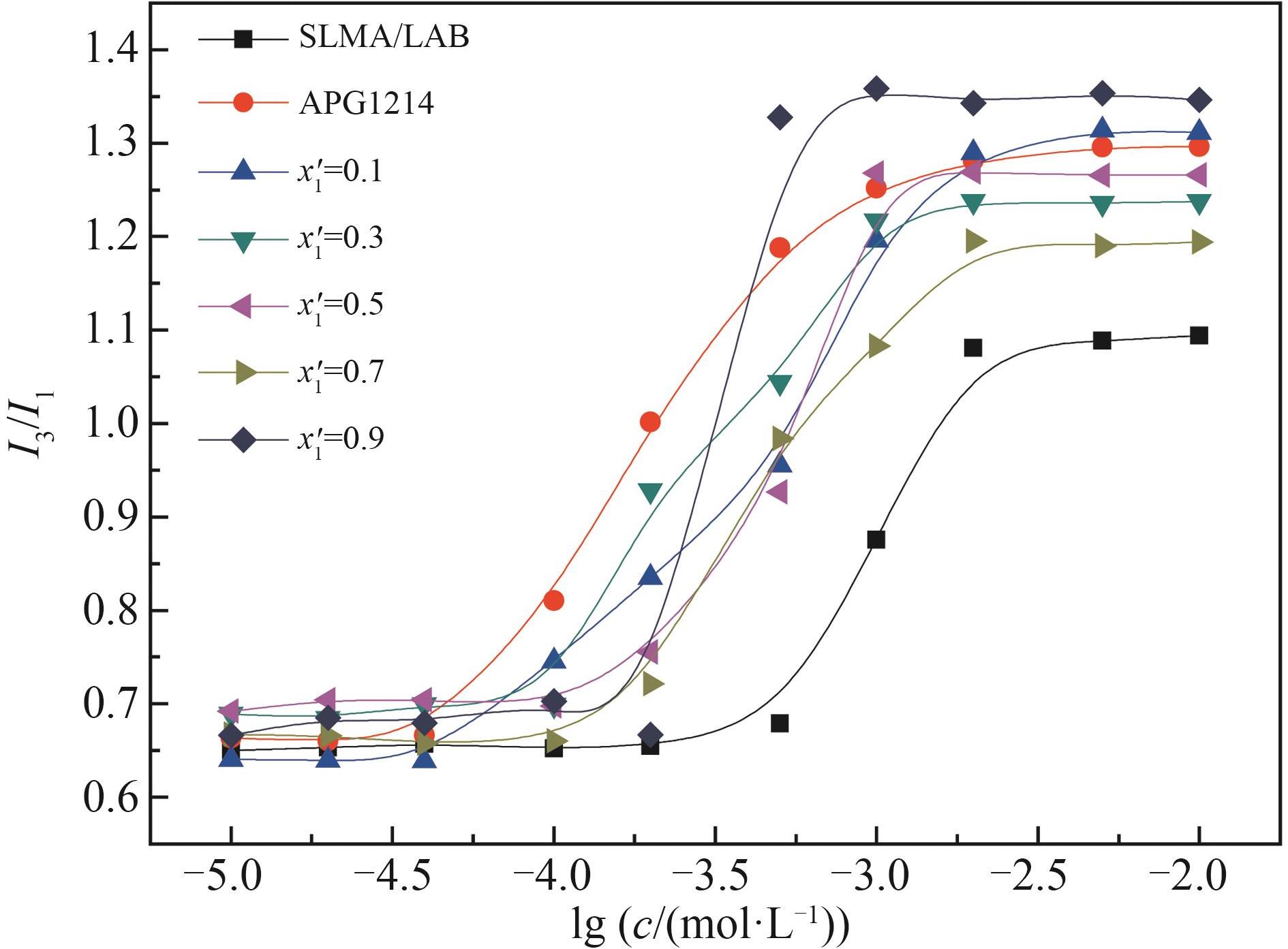
Fig.4 Micro-polarity curves of SLMA/LAB/APG ternary compound system in different proportions at 25 ℃Note:x1' is the molar fraction of SLMA/LAB with molar ratio of 3∶7 in the solution phase
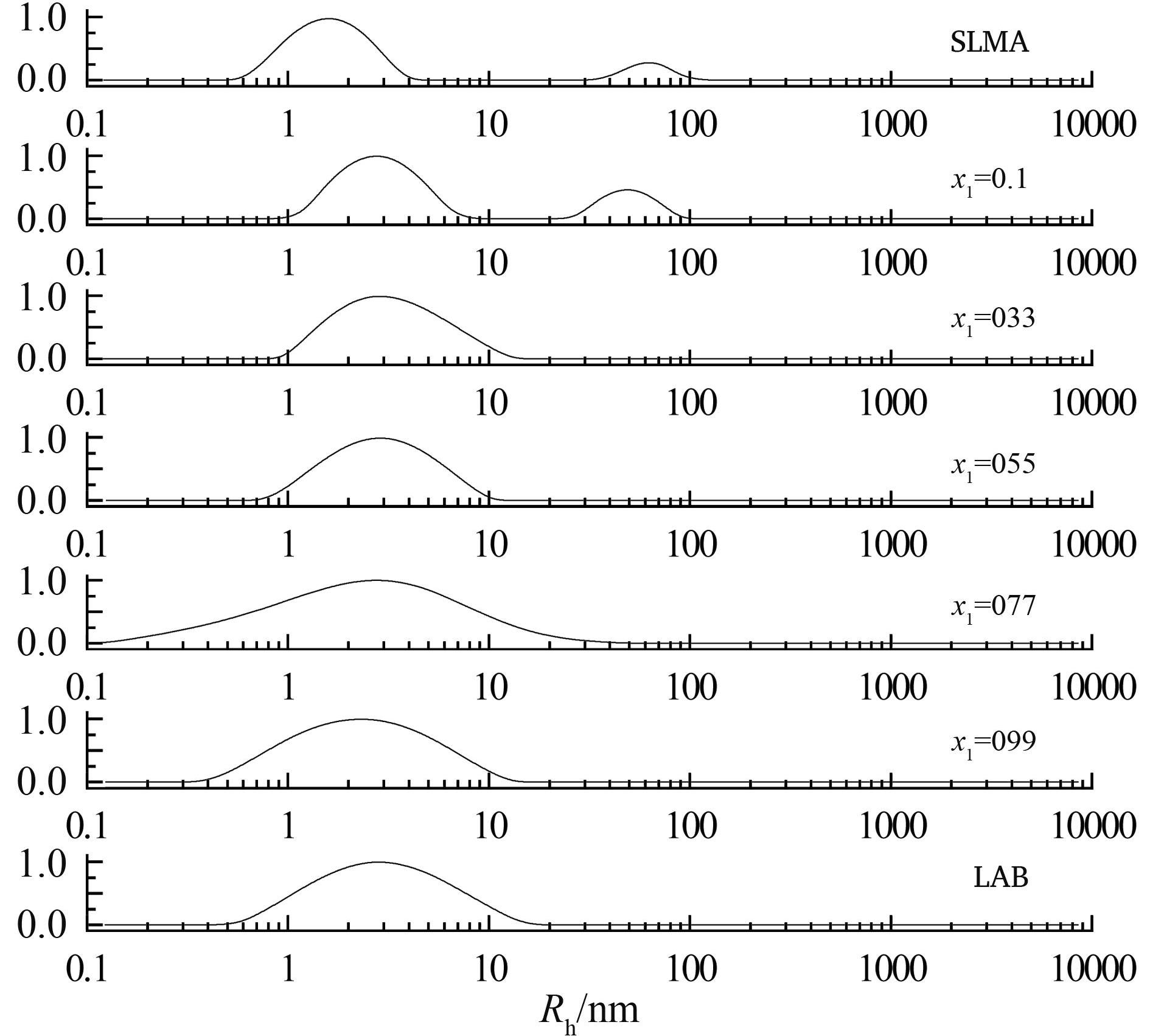
Fig.5 The average hydrodynamic radius and micelle distribution of the SLMA/LAB binary compound system and single components at 25 ℃ (x1 is the molar fraction of SLMA in the solution phase)
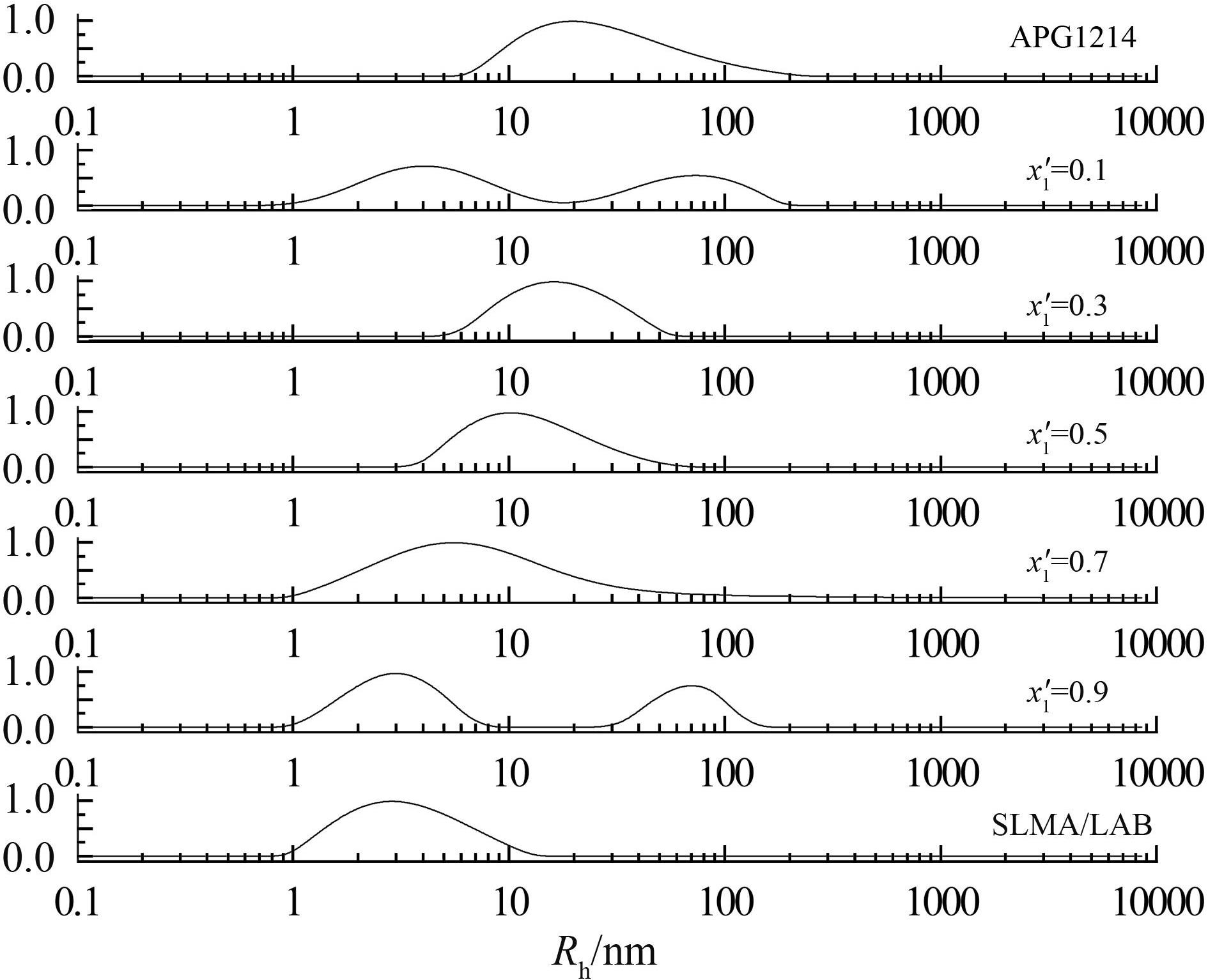
Fig.6 The average hydrodynamic radius and micelle distribution of the SLMA/LAB/APG ternary compound system and single components at 25 ℃ (x1' is the molar fraction of SLMA/LAB with molar ratio of 3∶7 in the solution phase)
| x1 | 0 | 0.1 | 0.3 | 0.5 | 0.7 | 0.9 | 1 |
|---|---|---|---|---|---|---|---|
| Nm | 45 | 40 | 44 | 41 | 38 | 35 | 47 |
Table 5 The number of micelle aggregation in the SLMA/LAB binary compound system
| x1 | 0 | 0.1 | 0.3 | 0.5 | 0.7 | 0.9 | 1 |
|---|---|---|---|---|---|---|---|
| Nm | 45 | 40 | 44 | 41 | 38 | 35 | 47 |
| 0 | 0.1 | 0.3 | 0.5 | 0.7 | 0.9 | 1 | |
|---|---|---|---|---|---|---|---|
| Nm | 49 | 31 | 34 | 42 | 37 | 35 | 44 |
Table 6 The number of micelle aggregation in the SLMA/LAB/APG ternary compound system
| 0 | 0.1 | 0.3 | 0.5 | 0.7 | 0.9 | 1 | |
|---|---|---|---|---|---|---|---|
| Nm | 49 | 31 | 34 | 42 | 37 | 35 | 44 |
| 1 | 毛雪彬, 洪玉倩, 徐坤华, 等.氨基酸基表面活性剂的应用进展[J].中国洗涤用品工业, 2018(10): 44-47. |
| MAO X B, HONG Y Q, XU K H, et al. Application progress of amino acid-based surfactants[J]. China Clean Ind, 2018(10): 44-47. | |
| 2 | 王杰, 薄纯玲, 王淑钰, 等.氨基酸型表面活性剂的进展[J].中国洗涤用品工业, 2018(6): 61-68. |
| WANG J, BO C L, WANG S Y, et al. Development of amino acid surfactants[J]. China Clean Ind, 2018(6): 61-68. | |
| 3 | 刘青.官能化氨基衍生的琥珀酸单十二酯钠盐类氨基酸表面活性剂的合成与性能测试[D].长沙: 湖南师范大学,2015. |
| LIU Q. Synthesis and performance test of amino acid surfactant derived from functionalized amino group[D]. Changsha: Hunan Normal University, 2015. | |
| 4 | IMABAYASHI Y, YOSHIKAWA S, TAKAHASHI K. Studies on the application of surfactants derived from amino acid. part 1: on the detergency of cloths soiled with carbon black and fatty acid[J]. Sen'i Seihin Shohi Kagaku, 1986, 27(5): 219. |
| 5 | 程海涛, 李军生, 汪涛, 等. N‑椰子油酰基复合氨基酸表面活性剂的合成[J]. 日用化学工业, 2010, 40(1): 14-17. |
| CHENG H T, LI J S, WANG T, et al. Synthesis of N‑coconut oil acyl compound amino acid surfactant[J]. China Surfactant Deterg Cosmet, 2010, 40(1): 14-17. | |
| 6 | 王宽, 孙吉龙, 李泽勇. 月桂酰肌氨酸钠自增稠体系的研究[J]. 日用化学工业, 2018, 48(12): 680-683. |
| WANG K, SUN J L, LI Z Y. Study on self-thickening system of sodium lauroyl sarcosinate[J]. China Surfactant Deterg Cosmet, 2018, 48(12): 680-683. | |
| 7 | 卢海伟.氨基酸型/两性表面活性剂复配增稠体系及流变性研究[D]. 上海:华东理工大学,2013. |
| LU H W. Study on the self-assembly thickening and rheological behaviors in mixed systems of amino acid-based/zwitterionic surfactants[D]. Shanghai: East China University of Science and Technology, 2013. | |
| 8 | 李伟, 刘方方, 张向彬. C12 BE-SDS-TX-10三元表面活性剂非理想溶液复配增效作用[J].应用化学, 2006,23(8): 907-912. |
| LI W, LIU F F, ZHANG X B. C12 BE-SDS-TX-10 ternary surfactant non-ideal solution compound synergistic effect[J]. Chinese J Appl Chem, 2006, 23(8): 907-912. | |
| 9 | 刘佳佳, 谢益诚, 许虎君. 一种阳离子Gemini型沥青乳化剂的合成及性能[J]. 应用化学, 2018, 35(5): 552-558. |
| LIU J J, XIE Y C, XU H J. Synthesis and performance of a cationic gemini asphalt emulsifier[J]. Chinese J Appl Chem, 2018, 35(5): 552-558. | |
| 10 | 崔正刚.表面活性剂、胶体与界面化学基础[M]. 北京: 化学工业出版社, 2013: 1-318. |
| CUI Z G. Surfactant, colloid and interface chemistry basis[M]. Beijing: Chemical Industry Press, 2013: 1-318. | |
| 11 | ROSEN M J, KUNJAPPU J T. Surfactants and interfacial phenomena[M]. 4th Edition. New Jersey: John Wiley & Sons Inc, 2012: 1-347. |
| 12 | 赵国玺.表面活性剂物理化学[M]. 北京: 北京大学出版社, 1984: 1-502. |
| ZHAO G X. Physical chemistry of surfactants[M]. Beijing: Peking University Press, 1984: 1-502. | |
| 13 | 陈丹丹, 许虎君, 赵伟. 三联阳离子表面活性剂的合成及复配性能[J]. 应用化学, 2007, 24(10): 1211-1215. |
| CHEN D D, XU H J, ZHAO W. Synthesis and compound properties of triple cationic surfactants[J]. Chinese J Appl Chem, 2007, 24(10): 1211-1215. | |
| 14 | 朱海林, 胡志勇, 王建龙, 等. 烷基二苄醚双季铵盐的合成及在水溶液中的聚集行为[J]. 精细化工, 2013, 30(12):1374-1378. |
| ZHU H L, HU Z Y, WANG J L, et al. Synthesis of alkyl dibenzyl ether diquaternary ammonium salt and its aggregation behavior in aqueous solution[J]. Fine Chem Ind, 2013, 30(12): 1374-1378. | |
| 15 | 李新宝, 徐丽, 孟校威, 等. 稳态荧光探针法测定三聚季铵盐表面活性剂的胶束聚集数[J].物理化学学报, 2005,21(12):1403-1406. |
| LI X B, XU L, MENG X W, et al. Determination of micellar aggregation number of trimeric ouaternary ammonium surfactant by steady-state fluorescence probe method[J]. Acta Phys-Chim Sin, 2005, 21(12):1403-1406. | |
| 16 | 蒋福宾, 曾华辉, 杨正业, 等.稳态荧光探针法测定松香基季铵盐Gemini表面活性剂胶束聚集数[J]. 应用化学,2008, 25(10): 1166-1170. |
| JIANG F B, ZENG H H, YANG Z Y, et al. Steady-state fluorescence probe method for the determination of rosin-based quaternary ammonium salt gemini surfactant micelle aggregation number[J]. Chinese J Appl Chem, 2008, 25(10): 1166-1170. | |
| 17 | 丁振军. 表面活性剂的复配及应用性能研究[D].无锡: 江南大学, 2007. |
| DING Z J. Study on the compound and application performance of surfactants[D]. Wuxi: Jiangnan University, 2007. | |
| 18 | 孟方. 脂肪酸磺烷基酰胺和磺烷基酯的合成与性能研究[D]. 无锡: 江南大学, 2019. |
| MENG F. Study on the synthesis and properties of fatty acid sulfoalkyl amides and sulfoalkyl esters[D]. Wuxi: Jiangnan University, 2019. | |
| 19 | WANG Z Y, ZHANG S F, YUN F, et al. Synergistic behavior between zwitterionic surfactant α-decylbetaine and anionic surfactant sodium dodecyl sulfate[J]. J Surfactants Deterg, 2010, 13(4): 381-385. |
| 20 | MYSELS K J, PRINCEN L H. Light scattering by some laurylsulfate solutions[J]. J Phys Chem C, 1959, 63(10): 1696-1700. |
| [1] | Peng-Hui FAN, Jie LIU, Sheng-Hui LOU, Tao TANG. Research Progress on Synergists of Phosphorous Flame Retardants in Epoxy Resin [J]. Chinese Journal of Applied Chemistry, 2023, 40(5): 653-665. |
| [2] | Xiao-Mei HUANG, Xiang DENG, Lang-Man XING, Wei CHEN, Li SUN, Xiao-Yu ZHU. Study of Electrochemical Non-enzyme Glucose Sensor Based on Cu(Ⅱ)Co(Ⅱ) Bimetallic Carbon Nanosheets [J]. Chinese Journal of Applied Chemistry, 2022, 39(12): 1891-1902. |
| [3] | BI Yipiao, GONG Xue, YANG Fa, RUAN Mingbo, SONG Ping, XU Weilin. Polyvalent MnOx/C Electrocatalyst for Highly Efficient Nitrogen Reduction Reaction [J]. Chinese Journal of Applied Chemistry, 2020, 37(9): 1048-1055. |
| [4] | ZHU Zhaoqiang,DU Weimin,GUO Wei,ZHU Wenjuan. Research Progress of Preparation and Application of Transition Metal Ternary Compounds in Supercapacitors [J]. Chinese Journal of Applied Chemistry, 2016, 33(3): 267-276. |
| [5] | CHEN Qi, FEI Xia, HE Qinqin, WU Qiliang, HE Bing, LIU Xueting*. Synthesis, Characterization and Synergistic Effect of Tb-loaded Mesoporous Titanium Dioxide [J]. Chinese Journal of Applied Chemistry, 2014, 31(10): 1222-1228. |
| [6] | DING Wei1*, REN Ya′ni1, LIU Hongbin1, SHI Peng1, YU Tao1, QU Guangmiao1, CHENG Jiecheng2, WU Junzheng2. Effect of Relative Molecular Mass on the Adsorption of Alkyl Aryl Sulfonate Composite Systems at the Solid-Liquid Interface [J]. Chinese Journal of Applied Chemistry, 2011, 28(08): 963-968. |
| [7] | Lu Changqing, Han Yinglin, Ma Yingjun, Zhao Renhui, Diao Yuemin. Performance and Synergistic Effect of Scale Inhibitors [J]. Chinese Journal of Applied Chemistry, 1996, 0(1): 83-85. |
| Viewed | ||||||
|
Full text |
|
|||||
|
Abstract |
|
|||||